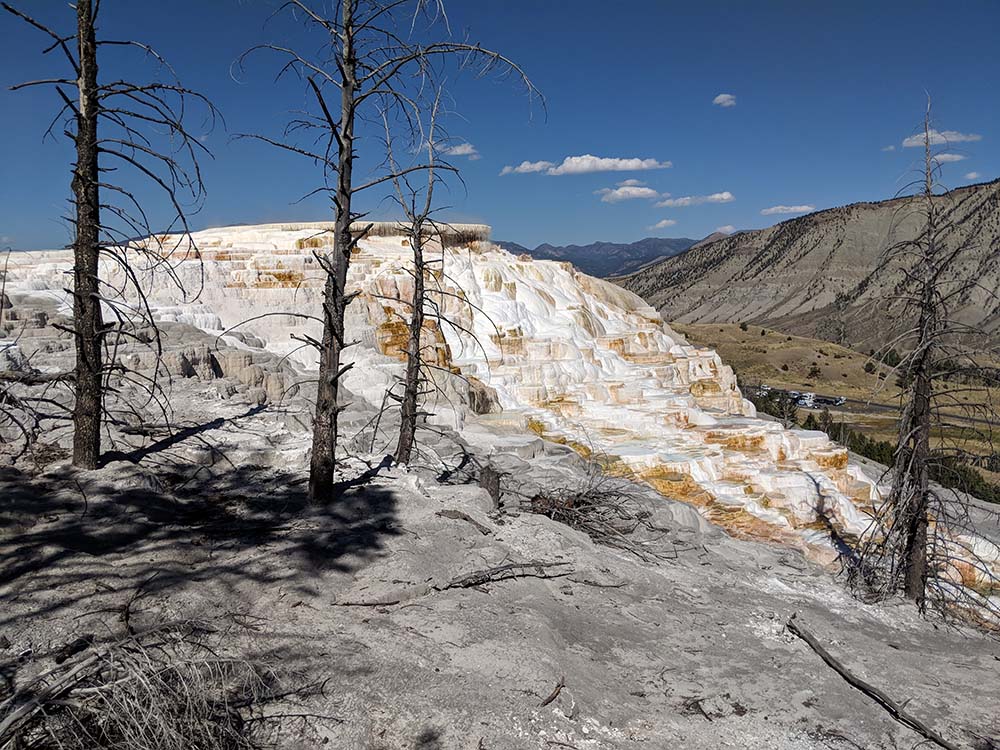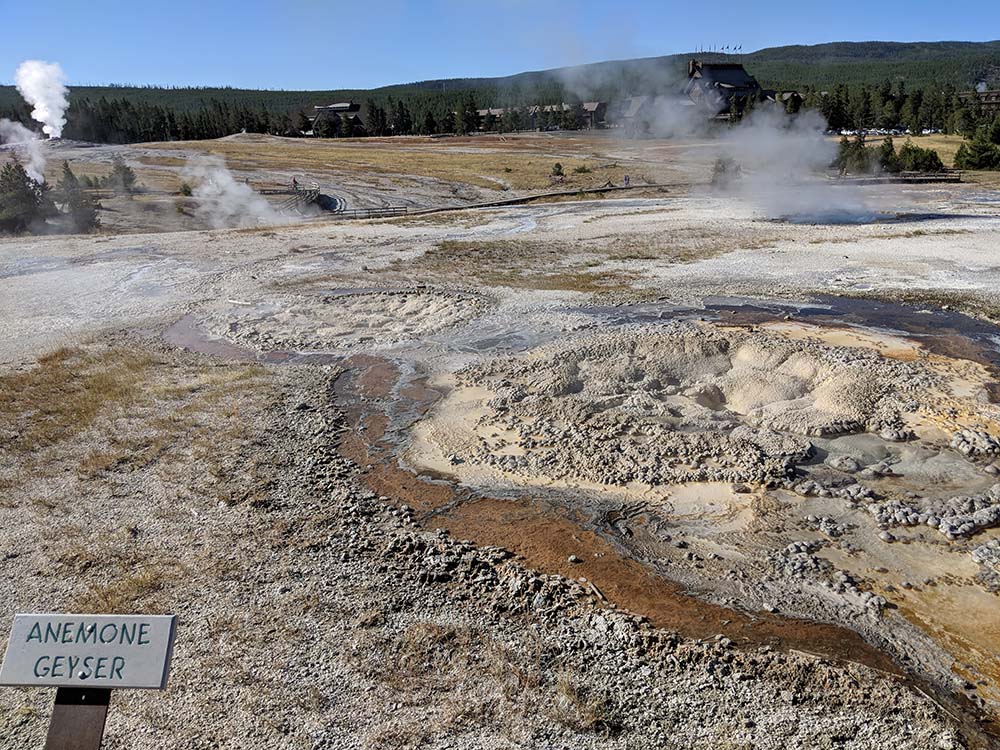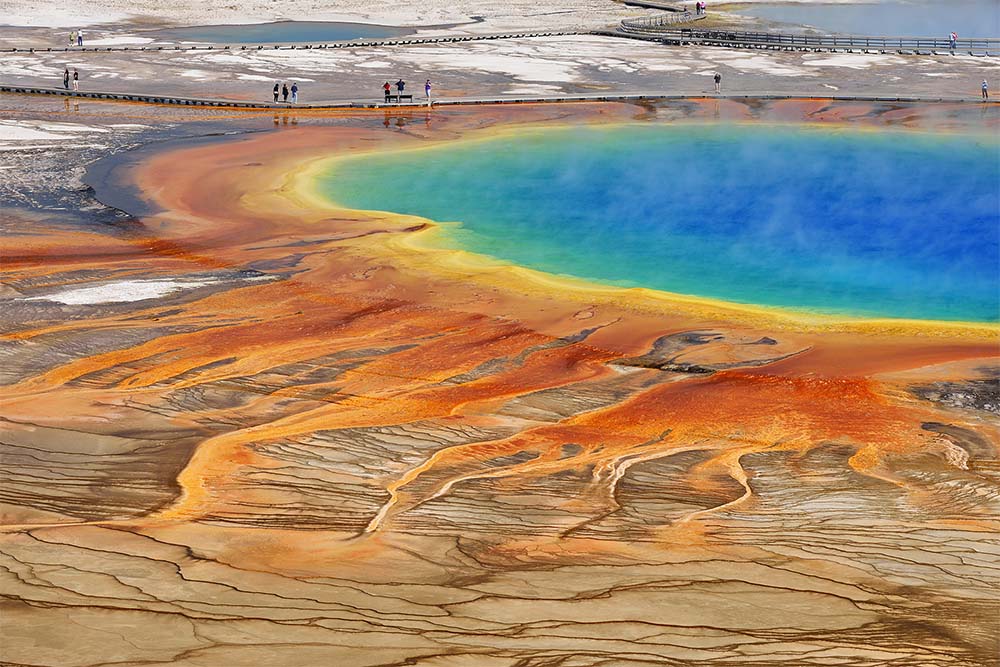The geothermal features in Wyoming’s Yellowstone National Park are awe-inspiring, must-see natural wonders. However, the vastness of Yellowstone can get overwhelming as you try to see it all. We’ve gathered a few of our favorite geothermal features, showing there is certainly more to see in Yellowstone than Old Faithful.
Before we get into our favorites, take a look at this run-down of the five types of hydrothermal features you’ll see in Yellowstone. Here they are, in no particular order:
Hot springs: Pools of hydrothermally heated water.
Geysers: Hot springs with constrictions in their plumbing, which causes them to periodically erupt to release the pressure that builds up.
Mudpots: Hot springs that are acidic enough to dissolve the surrounding rock and typically also lack water in their systems.
Travertine terraces: Hot springs that rise up through limestone, dissolve the calcium carbonate and deposit the calcite that makes the travertine terraces.
Fumaroles: These hot features, also known as steam vents, lack water in their system, and instead constantly release hot steam.
Most Impressive: Upper Terraces
The Terraces at Mammoth Hot Springs are especially impressive because of the size of them and the fact that they are moving and growing (which often means boardwalks have to move too!) They are a beautiful bright white with darker yellows intermixed.
The 1.7 miles of boardwalks protect the delicate features, yet allow you to really see the levels of terraces from different views.
We also love driving (or, better yet, cross-country skiing in the winter) the Terrace loop for a view of Orange Mound on the backside of the terraces.

A view of the Upper Terraces in Yellowstone National Park.
Loudest from the Inn: Beehive Geyser
Beehive is a favorite in the Upper Geyser basin. It erupts less frequently than Old Faithful (only about twice a day), but it is taller (up to 200 feet) and lasts longer (about 4-5 minutes).
Be prepared to get wet if you’re on the boardwalk next to it; wind going in the right direction will result in you getting drenched from the spray.
Fun Fact: Beehive Geyser happens to roar loud enough to hear from inside the Old Faithful Inn on a quiet night.
Most Fun to Watch: Mud Pots
While Yellowstone’s geysers are impressive in their few minutes of glory, the mud pots are truly mesmerizing. They bubble, gurgle and splatter. Due to the hydrogen sulfide gas they emit, they also smell like rotten eggs (so be prepared!)
Plan on spending some time just sitting and watching them; it’s surprisingly calming.
Oldest: Castle Geyser
Actually, Castle may be the oldest, as it’s very hard to know for sure. However, experts agree that its 12-foot high cone proves that it has been building via mineral deposits from eruptions for anywhere from 5,000 to 15,000 years.
The geyser itself currently erupts every 9 to11 hours, and the jet is up to 90 feet tall.
Most Intriguing: Anemone Geyser
Anemone Geyser is our favorite because it’s like watching a toilet flush or a bathtub drain. Every few minutes you can watch it fill up, splash-erupt, then drain again.
Anemone Geyser is especially great for kids because you can get very close to it on the boardwalks and spend some time watching the cycle repeat itself.

Anemone Geyser erupts every 6-10 minutes.
Tallest: Steamboat Geyser
Steamboat Geyser is the tallest geyser in the world, but it also happens to be extremely unpredictable. In fact, while since 2018 eruptions have been more frequent, previously it has gone as long as 50 years between eruptions.
Steamboat has been measured to shoot steamy water between 300 and 400 feet in the air.
Prettiest: Grand Prismatic & Morning Glory
Because of the changing temperatures and microorganisms within the pools, we can’t list just one!
Grand Prismatic is certainly the most well-known pool and appears in numerous Yellowstone glamour shots. And for good reason – the deep blue center and orange spider legs radiating out are simply stunning. Grand Prismatic happens to be Yellowstone’s largest single hot spring and the world’s third largest.
Avoid the crowds just a bit by climbing up the new trail to an overlook on the nearby hillside. The 0.6-mile hike is worth the view.

Grand Prismatic Spring is the largest hot spring in the United States.
Morning Glory is a great example of how much humans’ negligence can negatively affect thermal pools. Decades of litter being thrown in the pool actually clogged the heat sources and cooled it off. The change in temperature allowed new photosynthetic microorganisms to live there, which also changed the color.
The good news is that in recent years, attempts have been made despite challenging conditions to clean out the ‘Garbage Can’ and vibrant colors are coming back.